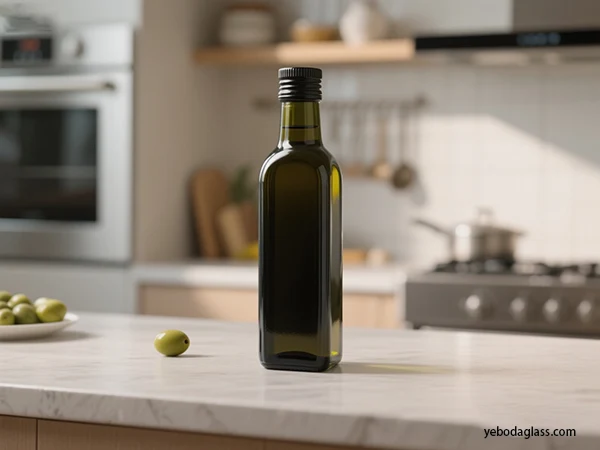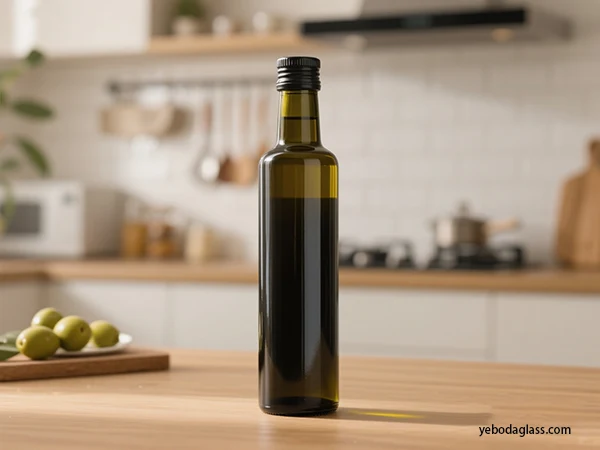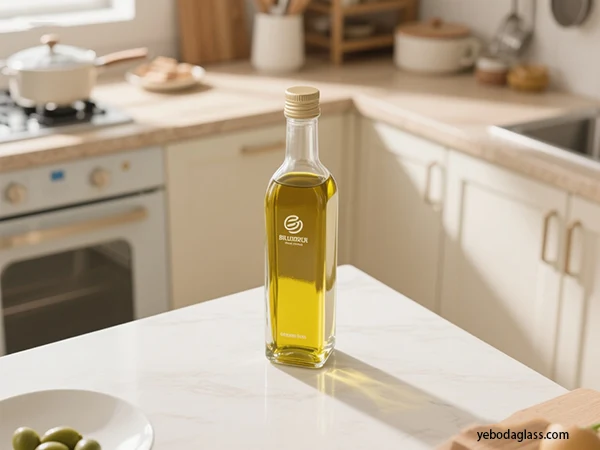Introducción
Reusable packaging:

In particular, the concept of the reusable glass container and all cleaning/refilling solutions (although less common for direct-from-factory wholesale) contributes to waste reduction.
Key Certs You Kinda Need for Olive Oil Containers Alright, here’s the drill: ISO 9001: Basically, this means the company isn’t just flying by the seat of its pants when it comes to quality. If you don’t see this, start raising your eyebrow.
BRC (British Retail Consortium):
- Vaso: FDA:
- Selling or importing into the U.S.? Gotta play by FDA’s rules for food contact. No exceptions. Well, except for people who enjoy legal trouble. SGS, CE:
- You’ll spot these around—think of them as the generic “yeah, we followed the rules” stickers for safety and quality. Not flashy, just necessary. FSC & SFI:
- Now, if you’re rocking paperboard for Bag-in-Box (BIB) packaging, you’ll want to see these. Means your packaging wasn’t made at the expense of some poor rainforest. Responsible forestry and all that good stuff. TLDR: If you’re missing any of these, time to double-check what—or who—you’re dealing with.
Customization vs. Standardized Solutions
Distributors need to choose between standard off-the-shelf olive oil containers or custom-designed options. Each option has its own merits and shortcomings.
- Standardized Olive Oil Container Options Benefits:
- Lower cost: Standard containers mass produced will typically have lower unit costs based on economies of scale.
Less lead-time:
Generally higher availability translates to shorter lead-times.
- Less MOQ: Often associated with lower Minimum Order Quantities making them accessible to smaller distributors or as trial runs.
- Proven design: They have been tested for function and consumer acceptability.
- Drawbacks: fewer branding options:
- There is a lower degree of unique brand differentiation. More available to competitors:
Competitors can easily purchase the same packaging
Custom-Designed Olive Oil Container Solutions
Distinctive Brand Identity:
- Custom design allows for unique bottle shapes, colors, and finishes to be created, differentiating your product into the desired positioning and premium image. Added Functionality:
- Bespoke designs can incorporate functionality for improved pouring, dispensing, or preservation. Custom design can provide a level of exclusivity.
- Increased Cost: Custom run tooling, design, and lower production volumes will generally provide a higher unit price.
- Durabilidad: Cost, design, prototyping, tooling and production setup time frames can substantially delay delivery schedules.

Increased MOQs:
- 4.1. Reciclaje en Círculo Cerrado y Certificaciones Cost in Design and Development:
- Cost associated with design expertise and possibly prototyping. Customization Options for Olive Oil Container
- Manufacturers provide a variety of customization options for standard and custom containers: Bottle Design and Shape:
Standard bottles can be round, square, or custom proprietary shapes.
- Bottle Color: Most cans/containers are made from clear, green, or amber glass. Colors can be specified during the manufacturing process such as matte black or custom colors.
- Bottle Surface Decoration: Surface decoration such as: silkscreen printing, labelling, hot stamping, frosting, spray painting, etching, engraving, and many more options are available for branding and aesthetics.
- Lids and Closures: Any type of lid can be applied to bottle. There are endless options for colors and type of closure. Lids can also be designed for tamper evidence.
- Mockup Resources for Olive Oil Container Mockups are a great resource for distributors and designers looking for custom bottle designs. Many websites like UnicDesign, Creatsy, and Etsy offer mockup templates in Photoshop (PSD) files that allow you to see a realistic image of your label designs on various bottle types including olive oil bottles. Mockups allow for a large range of customization of the bottle elements, shadows, and backgrounds which is helpful in presenting design concepts to clients and to add new projects to your portfolio.
- Future Trends and Innovations in Olive Oil Packaging Man, the packaging game? It’s gotten wild lately—especially with everyone yelling about eco-friendliness, not wrecking the planet, and, you know, actually making stuff work for humans. Distributors really need to keep their heads on a swivel if they wanna stay ahead.
Next-Level Sustainable Stuff for Olive Oil Containers
We’re way past just shoving everything in some half-arsed recycled plastic. People are cooking up containers made from plants, mushrooms, even friggin’ seaweed now! Stuff that legit breaks down instead of haunting landfills for centuries. Compost it, bury it, feel a little less guilty about loving olive oil.
Smart Packaging—’Cause Even Your Olive Oil Can Be a Nerd
Packaging is getting brains, whether you asked for it or not. We’re talking packaging that snitches on itself.
Beneficios:
- Imagine the bottle telling you, “Hey, I’m about to turn rancid, bud”—like, actual color changes, not just those sketchy expiration dates you ignore. There’s this new thing with cellulose nanofibers, methylene blue, and vitamin C—sounds like something from a lab, but it’s in your kitchen. Traceability Tech:
- QR codes, NFC chips, RFID tags, and that whole blockchain jazz. Swipe your phone and boom—proof your olive oil is legit and didn’t get swapped by some shady dealer. Italians, apparently, will fork over extra cash for these receipts. Honestly, can you blame them? TTIs (Time-Temperature Indicators):
- Fancy little gadgets log how hot (or not) the bottle’s gotten during shipping. Olive oil’s finicky—if it gets too toasty, it’s toast. These things help keep the good stuff good. Fancy New Ways to Pour Olive Oil
- Why settle for leaky, messy bottles? People keep inventing spouts and dispensers that give you the perfect drizzle, keep air out, and save you from that sad “oops, too much” moment over your salad. Bonus: less air in the bottle, so your oil lasts longer. Less is More—Lightweight & Low-Waste Olive Oil Packaging
Everybody’s cutting down on wasted material. Lighter bottles, smaller lids, thinner walls—but not at the expense of your countertop (or your shirt) surviving the experience. Sure, it saves cash, but yeah, the environment’s happy too.
- Bulletproofing Olive Oil—Barrier Tech No one wants light or oxygen turning their fancy olive oil into some chemical swamp. Cue the science wizards: they’re making better shields for bottles and jars so your oil stays fresh, not funky. Plastics, glass, weird new coatings—if it keeps out the bad stuff, they’re on it.
- Going Full Circle—Closed-Loop Olive Oil Packaging Recyclable, reusable, maybe even refilling stations one day? Brands are shooting for packaging that doesn’t just end up in the bin. Closed-loop systems are all the rage, so your empties might get more lives than your iPhone gets updates. Bottom line? Distributors gotta catch these waves, or get stuck watching from the beach. The olive oil packaging world’s not just keeping up—it’s sprinting, and you wanna be out front, not eating its dust.
Read more related articles: How to Source Premium Olive Oil Glass Bottles in Bulk?
Ventajas:
- Comments Submit A Review
- We’ve got you covered 24/7/365. Feel free to contact us, and get free samples. Hot Products
- Protección de la Propiedad Intelectual: 100-300ml Round Glass Yogurt Milk Bottle – Small Dessert Jars Bulk
Desventajas:
- Oil Bottles Bulk Supply Guide: Save Costs, Boost Efficiency Full Name
- We focus on wholesale business, MOQ 1,000 pcs. Cost, design, prototyping, tooling and production setup time frames can substantially delay delivery schedules.
- Increased MOQs: Custom designed tooling and production runs usually require a higher volume of orders.
- Cost in Design and Development: Cost associated with design expertise and possibly prototyping.
Customization Options for Olive Oil Container
Manufacturers provide a variety of customization options for standard and custom containers:
- Bottle Design and Shape: Standard bottles can be round, square, or custom proprietary shapes.
- Color de la botella: Most cans/containers are made from clear, green, or amber glass. Colors can be specified during the manufacturing process such as matte black or custom colors.
- Bottle Surface Decoration: Surface decoration such as: silkscreen printing, labelling, hot stamping, frosting, spray painting, etching, engraving, and many more options are available for branding and aesthetics.
- Lids and Closures: Any type of lid can be applied to bottle. There are endless options for colors and type of closure. Lids can also be designed for tamper evidence.

Mockup Resources for Olive Oil Container
Mockups are a great resource for distributors and designers looking for custom bottle designs. Many websites like UnicDesign, Creatsy, and Etsy offer mockup templates in Photoshop (PSD) files that allow you to see a realistic image of your label designs on various bottle types including olive oil bottles. Mockups allow for a large range of customization of the bottle elements, shadows, and backgrounds which is helpful in presenting design concepts to clients and to add new projects to your portfolio.
Future Trends and Innovations in Olive Oil Packaging
Man, the packaging game? It’s gotten wild lately—especially with everyone yelling about eco-friendliness, not wrecking the planet, and, you know, actually making stuff work for humans. Distributors really need to keep their heads on a swivel if they wanna stay ahead.
Next-Level Sustainable Stuff for Olive Oil Containers
We’re way past just shoving everything in some half-arsed recycled plastic. People are cooking up containers made from plants, mushrooms, even friggin’ seaweed now! Stuff that legit breaks down instead of haunting landfills for centuries. Compost it, bury it, feel a little less guilty about loving olive oil.
Smart Packaging—’Cause Even Your Olive Oil Can Be a Nerd
Packaging is getting brains, whether you asked for it or not. We’re talking packaging that snitches on itself.
- Shelf-Life Indicators: Imagine the bottle telling you, “Hey, I’m about to turn rancid, bud”—like, actual color changes, not just those sketchy expiration dates you ignore. There’s this new thing with cellulose nanofibers, methylene blue, and vitamin C—sounds like something from a lab, but it’s in your kitchen.
- Traceability Tech: QR codes, NFC chips, RFID tags, and that whole blockchain jazz. Swipe your phone and boom—proof your olive oil is legit and didn’t get swapped by some shady dealer. Italians, apparently, will fork over extra cash for these receipts. Honestly, can you blame them?
- TTIs (Time-Temperature Indicators): Fancy little gadgets log how hot (or not) the bottle’s gotten during shipping. Olive oil’s finicky—if it gets too toasty, it’s toast. These things help keep the good stuff good.
Fancy New Ways to Pour Olive Oil
Why settle for leaky, messy bottles? People keep inventing spouts and dispensers that give you the perfect drizzle, keep air out, and save you from that sad “oops, too much” moment over your salad. Bonus: less air in the bottle, so your oil lasts longer.

Less is More—Lightweight & Low-Waste Olive Oil Packaging
Everybody’s cutting down on wasted material. Lighter bottles, smaller lids, thinner walls—but not at the expense of your countertop (or your shirt) surviving the experience. Sure, it saves cash, but yeah, the environment’s happy too.
Bulletproofing Olive Oil—Barrier Tech
No one wants light or oxygen turning their fancy olive oil into some chemical swamp. Cue the science wizards: they’re making better shields for bottles and jars so your oil stays fresh, not funky. Plastics, glass, weird new coatings—if it keeps out the bad stuff, they’re on it.
Going Full Circle—Closed-Loop Olive Oil Packaging
Recyclable, reusable, maybe even refilling stations one day? Brands are shooting for packaging that doesn’t just end up in the bin. Closed-loop systems are all the rage, so your empties might get more lives than your iPhone gets updates. Bottom line? Distributors gotta catch these waves, or get stuck watching from the beach. The olive oil packaging world’s not just keeping up—it’s sprinting, and you wanna be out front, not eating its dust.




